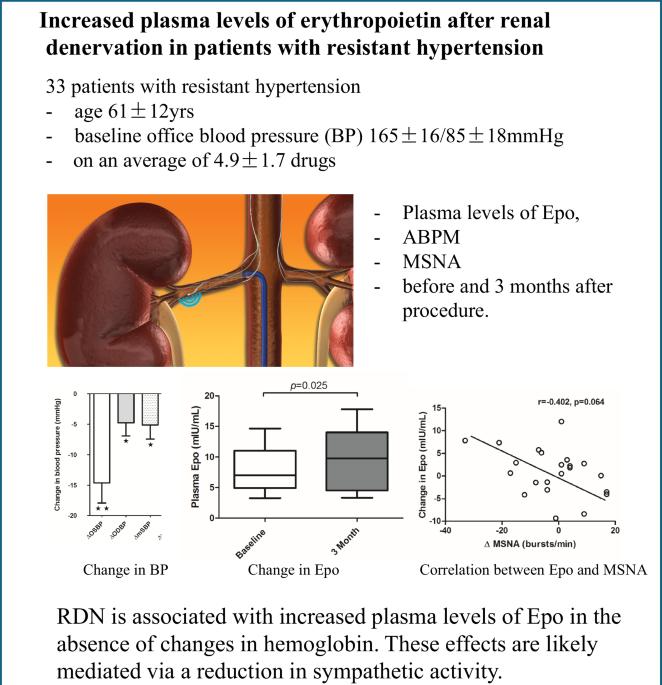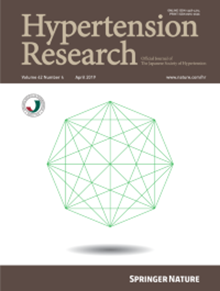Increased plasma levels of erythropoietin after renal denervation in patients with resistant hypertension
IF 4.6
2区 医学
Q1 PERIPHERAL VASCULAR DISEASE
引用次数: 0
Abstract
Erythropoietin (Epo) plays a crucial role in the formation and maturation of erythrocytes and is produced primarily by peritubular cells in the renal cortex. Previous studies suggest that renal sympathetic nerve activity (RSNA) may influence Epo regulation. Catheter-based renal denervation (RDN) has been shown to reduce renal noradrenaline spillover and blood pressure in patients with resistant hypertension. We therefore aimed to investigate whether RDN influences Epo levels. 33 patients with resistant hypertension (age 61 ± 12 y; baseline office blood pressure (BP) 165 ± 16/85 ± 18 mmHg despite treatment with an average of 4.9 ± 1.7 antihypertensive medications) underwent bilateral RDN. Plasma levels of Epo, office blood pressure, 24 h ambulatory blood pressure monitoring (ABPM), muscle sympathetic nerve activity (MSNA), renal function and haemoglobin were measured before the procedure and at 3 months follow-up. Antihypertensive medication was not changed during the first 3 months after RDN. Office blood pressure was reduced by 15 ± 19/5 ± 12 mmHg at 3 months after denervation (p < 0.001 for systolic BP; p = 0.033 for diastolic BP). 24h-mean systolic and diastolic BP were also reduced (from 145 ± 16 to 140 ± 18 mmHg; p = 0.036, and from 80 ± 11 to 77 ± 12 mmHg; p = 0.024), respectively. While haemoglobin levels remained unchanged, a significant increase in plasma Epo levels was observed at 3 months after RDN (7.81 ± 3.68 versus 9.88 ± 5.06 mIU/mL; p = 0.025). Changes in Epo levels correlated with baseline MSNA (r = 0.580, p = 0.004 for burst frequency; r = 0.471, p = 0.023 for burst incidence), such that the increase in Epo was most pronounced in patients with high baseline MSNA. The RDN-induced changes in MSNA tended to correlate inversely with changes in Epo levels (r = −0.402; p = 0.064). Our findings suggest that RDN is associated with increased plasma levels of Epo in the absence of changes in haemoglobin, and that these effects are possibly mediated via a reduction in sympathetic nerve activity.

顽固性高血压患者肾去神经后血浆促红细胞生成素水平升高。
促红细胞生成素(Epo)在红细胞的形成和成熟中起着至关重要的作用,主要由肾皮质的小管周围细胞产生。以往的研究表明,肾交感神经活动(RSNA)可能影响Epo的调节。基于导管的肾去神经支配(RDN)已被证明可以降低顽固性高血压患者的肾去甲肾上腺素溢出和血压。因此,我们的目的是研究RDN是否影响Epo水平。顽固性高血压33例(年龄61±12岁;基线办公室血压(BP) 165±16/85±18 mmHg,尽管平均4.9±1.7抗高血压药物治疗)进行双侧RDN。术前及随访3个月测定血浆促红细胞生成素水平、办公室血压、24小时动态血压监测(ABPM)、肌肉交感神经活动(MSNA)、肾功能和血红蛋白。在RDN后的前3个月内,降压药物没有改变。去神经后3个月办公室血压下降15±19/5±12 mmHg (p
本文章由计算机程序翻译,如有差异,请以英文原文为准。
求助全文
约1分钟内获得全文
求助全文
来源期刊

Hypertension Research
医学-外周血管病
CiteScore
7.40
自引率
16.70%
发文量
249
审稿时长
3-8 weeks
期刊介绍:
Hypertension Research is the official publication of the Japanese Society of Hypertension. The journal publishes papers reporting original clinical and experimental research that contribute to the advancement of knowledge in the field of hypertension and related cardiovascular diseases. The journal publishes Review Articles, Articles, Correspondence and Comments.
 求助内容:
求助内容: 应助结果提醒方式:
应助结果提醒方式:


